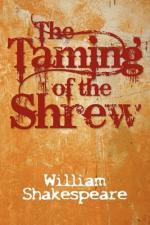|
This section contains 10,125 words (approx. 34 pages at 300 words per page) |

|
SOURCE: “The Ending of The Shrew,” in Shakespeare Studies, Vol. 18, 1986, pp. 41-64.
In the following essay, Burns asserts that the play's unity is established through the frame created by Sly's disappearance in the first act, and the “disappearance” of the shrew in the final act.
The central thematic and formal principle in The Taming of the Shrew is its conversion of oppositions into dialectics, so that initially adversarial relationships or hierarchies become vehicles of reciprocal exchange. This is accomplished in the relationship between Kate and Petruchio, in the relationship between the Induction and the main play, and ultimately in the relationship between the ending and the “missing” ending. All of these relationships are subsumed by the ending of the play.
The conclusion of Shrew poses two famous problems, the remarkable disappearance of Christopher Sly and the other Induction characters after Act I, and the ambiguity of Katherina's self-extinguishing...
|
This section contains 10,125 words (approx. 34 pages at 300 words per page) |

|


